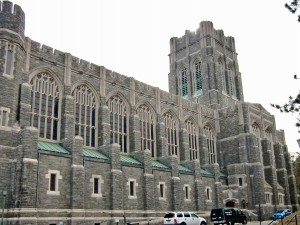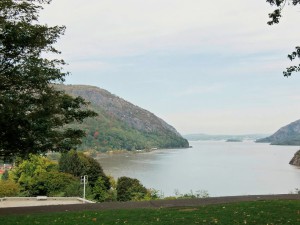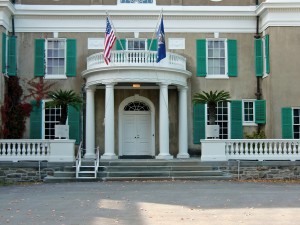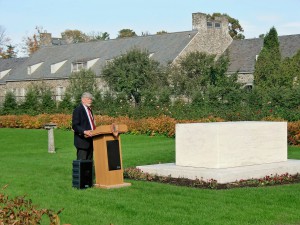EXPLORING NEW YORK – HEADING NORTH TO THE HUDSON VALLEY
EXPLORING NEW YORK
This is the fifth in a series of articles about traveling the byways of New York State
HEADING NORTH TO THE HUDSON VALLEY
By Charles N. Stevens
Photos by Dolores Seidman
Only a few wispy clouds mark an otherwise clear sky, a perfect day for our trip north to West Point, Hyde Park and Saratoga Springs. Once again we join the rush hour traffic on the Garden State Parkway, most motorists on their way to work while we are relaxed and on vacation. Here and there among the trees is a touch of yellow or the blush of a lone maple. At one point, a small flock of Canada geese rest and feed on a grassy median, oblivious to the cars whizzing by on both sides of them.
We cross over into New York, now traveling on the New York Thruway. The landscape gradually becomes hilly, the trees covering the slopes a pallet of autumn colors ranging from gold to blazing scarlet. Seeing the autumn colors is our main purpose for taking this trip, and at last we are gazing at them. Gray bluffs and outcroppings show us the insuflaveis dark granite that underlies the land. Blood-red sumac lines portions of the road while red-leafed poison ivy winds around tree trunks.
We know we are near West Point when we come upon the West Point Golf Course, surprisingly open to the public. Our bus enters the small town of Highland Falls, the village that exists because of its proximity to West Point. It is primarily made up of hotels and restaurants including Chinese, Mexican and even McDonald’s. We pull into the parking lot of the West Point Visitors Center. It provides displays chronicling the history of West Point which dates from 1802 and shows videos of modern cadet life. It is an ideal starting point for a docent-led visit to the grounds. A well-stocked gift shop offers a variety of souvenirs.
Once we pick up our guide, our bus rolls out into the West Point campus. We pass a large grassy space that used to be the equestrian training field. Over seven hundred horses were once stabled here, but now there are none. We see the Alumni Center and the athletic facilities as well as the 1924 Michie Stadium where the Army football team plays. Beyond it we come upon a large lake, trees and clouds mirrored in its stillness.
Our first stop is the gray stone Cadet Chapel with its massive tower and battlements making it look more like a fortress. I suppose this is appropriate for a military church. Inside, stained glass windows allow a feeble amount of light to penetrate the sanctuary, the chapel rather dark and shadowed beneath its gothic arches. A single candle burns for the missing in action and the military dead. Bibles and hymnals are distributed along the pews. This chapel is mainly for Protestant services, Catholics having a different chapel. Smaller facilities are provided for those of the Jewish or Muslim faith. Cadets cannot be married, so when they graduate a rash of weddings takes place in the chapel; sometimes there are six a day immediately after graduation.
Later we pass homes for the officers and vast grassy parade fields, more Canada geese nibbling on the grass after their flight southward. A grass-covered knoll looks down on the Hudson River as it winds through the hills, a breathtaking scene. Fallen oak leaves lay scattered on the lawns.
We stroll around a Civil War battle monument and the soft velvet green of the parade grounds, touch a cold black cannon that is still fired twice a day. We come upon a statue of General Douglas MacArthur who, we learn, had never had a demerit. The only other person equaling his record was Robert E. Lee, the Confederate General. In contrast General Dwight Eisenhower received many demerits, yet also became a great general.
As we pass by the Jefferson Library, the Doubleday Baseball Field and Thayer Hall, once used for horse training, our guide tells us that the cadets live three or four to a room. Classes begin at 7:15 a.m. and end at 3:45 p.m., all cadets involved in athletics having to practice after this time.
Now out of West Point and on our way north again, we enter flatter country with the wide Hudson River flowing through it. We roll through Newburgh, New York with its fine old homes, yellow, orange and russet chrysanthemums adorning many of their porches. Chrysanthemums are so prevalent that we see them at McDonald’s and even a gas station. They are a part of autumn in the east. Although the scenery is attractive, parts of it along the highway could be classified as “American Ugly”—gas stations, shops, car dealers and traffic.
Off Highway 9 we turn into the Roosevelt estate at Hyde Park. At first we drive through extensive fields, some scattered with rolled bales of hay, finally arriving at the Visitors Center. The property was actually owned by Franklin’s mother, her wealth emanating from a long line of Dutch traders.
With a ranger guiding our tour of the grounds, we walk by beds of chrysanthemums and a flock of Canada geese helping to trim the vast lawn. Fallen leaves and acorns litter the paths. We pause at the rose garden where both Franklin and Eleanor are buried. As we wait to enter the large Roosevelt house, a flight of honking geese fly directly over us, close enough that we can hear the singing of their wings.
Once inside, we stand in the main foyer, its white walls contrasting with an abundance of dark polished wood. Framed pictures of ships dominate one wall, perhaps related to FDR’s being appointed Assistant Secretary of the Navy in 1913 by Woodrow
Wilson. Franklin’s personal bird collection occupies one full corner of the same room. The upstairs bedrooms are all light and pleasant, especially Franklin’s mother’s that looks out on the Hudson River and the forested hills beyond.
Besides the house, there is a large museum displaying items from FDR’s life, one wing of which is devoted to Social Security, one of his favorite projects. On our way out we are treated to a short address in the rose garden given by Roosevelt’s grandson, David Roosevelt, in commemoration of Eleanor’s 126th birthday.
On our way again up Highway 9, we slow down in the charming town of Rhinebeck and the Rhinebeck Inn where Chelsea Clinton was recently married. In the autumn mode, pumpkins, hay bales and dried corn stalks are everywhere. Farther on we drive through apple orchards, the red fruit hanging on them like Christmas tree ornaments. Pumpkin patches add splashes or bright orange. All along the road, apples and pumpkins are for sale.
After a catfish dinner at the Cracker Barrel, night descending, we pass old defunct woolen mills that appear ghostly in the dark, finally arriving at our hotel for the night at Saratoga Springs.

The chapel at West Point resembles a fortress.

The grounds of West Point afford magnificent views of the Hudson River.

We approach the grand entrance to the Roosevelt house in Hyde Park.

We are lucky to find David Roosevelt , grandson of FDR, giving a birthday tribute to Eleanor Roosevelt.



